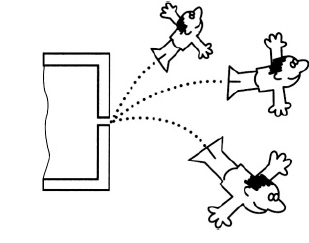


 الفيزياء الكلاسيكية
الفيزياء الكلاسيكية
 الكهربائية والمغناطيسية
الكهربائية والمغناطيسية
 علم البصريات
علم البصريات
 الفيزياء الحديثة
الفيزياء الحديثة
 النظرية النسبية
النظرية النسبية
 الفيزياء النووية
الفيزياء النووية
 فيزياء الحالة الصلبة
فيزياء الحالة الصلبة
 الليزر
الليزر
 علم الفلك
علم الفلك
 المجموعة الشمسية
المجموعة الشمسية
 الطاقة البديلة
الطاقة البديلة
 الفيزياء والعلوم الأخرى
الفيزياء والعلوم الأخرى
 مواضيع عامة في الفيزياء
مواضيع عامة في الفيزياء|
Read More
Date: 22-8-2016
Date: 3-9-2016
Date: 28-7-2016
|
Slowly Leaking Box
An ideal gas of atoms of number density n at an absolute temperature τ is confined to a thermally isolated container that has a small hole of area A in one of the walls(see Figure 1.1). Assume a Maxwell velocity distribution for the atoms. The size of the hole is much smaller than the size of the container and much smaller than the mean free path of the atoms.

Figure 1.1
a) Calculate the number of atoms striking the wall of the container per unit area per unit time. (Express your answer in terms of the mean velocity of the atoms.)
b) What is the ratio of the average kinetic energy of atoms leaving the container to the average kinetic energy of atoms initially occupying the container? Assume that there is no flow back to the container. Give a qualitative argument and compute this ratio.
c) How much heat must you transfer to/from the container to keep the temperature of the gas constant?
SOLUTION
a) The number of atoms per unit volume moving in the direction normal to the wall (in spherical coordinates) is
 (1)
(1)
where ϕ is the azimuth angle, θ is the polar angle, n is the number density of atoms, and f (v) is the speed distribution function (Maxwellian). To determine the number of atoms striking the area of the hole A on the wall per time dt, we have to multiply (1) by Av cos θ dt (only the atoms within a distance v cos θ dt reach the wall). To obtain the total atomic flow rate R through the hole, we have to integrate the following expression:
 (2)
(2)
We integrate from 0 to π/2 since we only consider the atoms moving toward the wall. On the other hand, by definition, the average velocity (v) is given by
 (3)
(3)
Comparing (2) and (3), we see that
 (4)
(4)
This result applies for any type of distribution function f (v). We only consider a flow from the inside to the outside of the container. Since the hole is small, we can assume that the distribution function of the atoms inside the container does not change appreciably.
b) The average kinetic energy of the atoms leaving the container should be somewhat higher than the average kinetic energy in the container because faster atoms strike the wall more often than the ones moving more slowly. So, the faster atoms leave the container at a higher rate. Let us compute this energy (ε1). For a Maxwellian distribution we have f (v) = Ce-mv2/2τ, where C is a normalizing constant:
 (5)
(5)
The numerator is the total energy of the atoms leaving the container per second, and the denominator is the total number of atoms leaving the container per second. Define 1/τ ≡ ζ. From part (a), we can express this integral in terms of the average velocity (v). Then we have
 (6)
(6)
We know that  (since it is a normalizing factor), and
(since it is a normalizing factor), and
 (7)
(7)
So (ε1) is indeed higher than the average energy of the atoms:
 (8)
(8)
c) From (b) we know that each atom leaving the container takes with it an additional energy ∆ε = (ε1) – (ε) = τ/2. The flow rate of the atoms leaving the container (from (a)) is
 (9)
(9)
The energy flow rate from the container becomes
 (10)
(10)
To keep the temperature of the atoms inside the container constant, we have to transfer some heat to it at the same rate:
 (11)
(11)
Equating the flow rate to the decrease of the number of atoms inside gives
 (12)
(12)
We then obtain
 (13)
(13)
Solving this differential equation, we can find the change in number density:
 (14)
(14)
is the time constant and n is the initial number density. Therefore, the heat flow rate is
 (15)
(15)



|
|
|
|
لخفض ضغط الدم.. دراسة تحدد "تمارين مهمة"
|
|
|
|
|
|
|
طال انتظارها.. ميزة جديدة من "واتساب" تعزز الخصوصية
|
|
|
|
|
|
|
جامعة سومر: حفل تخرج طلبة الجامعات يسهم بتنمية الروح الوطنية ويشجع على المثابرة والاجتهاد
|
|
|